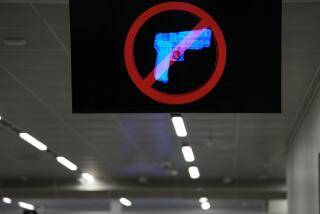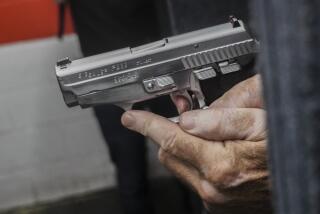High Court Cites New Rule, OKs Death Penalty
SAN FRANCISCO — The California Supreme Court, quickly applying its new landmark capital punishment ruling, upheld the death penalty Thursday for an Oakland parolee convicted of the robbery murder of a fellow member of a forgery ring.
In the first of what may be dozens of such decisions, the court by a 5-2 vote affirmed the death sentence of Oscar Gates for a December, 1979, fatal shooting in a dispute over the proceeds from the ring.
The justices, in upholding Gates’ sentence, cited the ruling they issued Tuesday that overturned a far-reaching 1983 decision under former Chief Justice Rose Elizabeth Bird requiring a finding of intent to kill before a defendant can be sent to the gas chamber.
The 1983 ruling resulted in death-penalty reversals in 13 cases where juries were not instructed to make such determinations. State prosecutors had calculated that at least 29 more capital cases were likely to require retrials had justices not overturned the Bird court decision earlier this week.
Thursday’s ruling was seen by prosecutors as the first of a series of decisions they expect in coming months that will be based on the new and more conservative court’s precedent-setting decision.
“This is the first shoe to drop following (Tuesday’s) ruling, which resolved one of the most important capital case issues,” said state Atty. Gen. John K. Van de Kamp. “The logjam of cases waiting for that resolution was broken by today’s decision and we expect to see cases based on similar challenges decided soon.”
In all, about 200 capital cases are pending on automatic appeal to the court, involving a wide range of legal issues.
The new court, now led by Chief Justice Malcolm M. Lucas, thus far has upheld death sentences in two of the four cases it has decided since three appointees of Gov. George Deukmejian joined the court following the defeat of Bird and two other justices in the November election. Under Bird, the court overturned 64 of 68 death sentences it considered.
Further appeals are pending in state and federal courts in the five sentences already affirmed--and the ruling in the Gates case will be taken next to the U.S. Supreme Court.
Signals Direction
In Thursday’s ruling, the court signaled, as it has in other recent cases, that it will not reverse criminal convictions and sentences because of trial procedural errors unless it is probable that they affected the verdict.
The justices acknowledged that some procedural errors had occurred in Gates’ trial--but concluded that none was serious enough to merit a new trial.
“Defendant was fairly tried, convicted and sentenced,” Justice Edward A. Panelli wrote in a 74-page majority opinion. “Whether viewed singly or cumulatively, no error in this case warrants reversal.”
Panelli’s opinion was joined by Lucas and Justices John A. Arguelles, David N. Eagleson and Marcus M. Kaufman. All five in the majority were appointed by Deukmejian.
In dissent, Justice Stanley Mosk, joined by Justice Allen E. Broussard, agreed that Gates’ conviction should be upheld, but said his sentence should be reversed because of confusing instructions by the trial judge on the jury’s duty to weigh aggravating and mitigating factors in the case.
Gates’ attorney, Judd C. Iversen of San Francisco, expressed disappointment with the ruling, saying he would seek a rehearing before the justices and, if denied, then appeal the ruling to the U.S. Supreme Court.
“When the (Tuesday) decision came down we knew we would have difficulty,” Iversen said. “But we still felt there were clear instructional errors elsewhere in the case that required a reversal.”
Fatal Shooting
Gates, while on parole for a 1973 rape conviction, was found guilty in the fatal shooting and robbery of Lonnie Stevenson and an assault and robbery of Maurice Stevenson, the murder victim’s nephew.
In conflicting testimony, prosecution witnesses said Gates had come to the Stevenson residence, shot the two men and stole their cash and jewelry. Gates acknowledged the shooting but said he had acted in self-defense in a dispute over his claim to a share of the proceeds from the forgery ring to which the three men belonged.
In the penalty phase of the trial, the prosecution cited as aggravating evidence Gates’ prior convictions for robbery, rape and kidnaping, as well as his alleged commission of a beating and murder of a woman in 1978 that had resulted in a hung jury.
The defense presented mitigating evidence from family members and others who testified that Gates, who is black, had encountered racial prejudice while growing up in Mississippi and had never been in trouble until an incident with a white-supremacist store owner. Later, they said, Gates had been beaten by police in California.
There was also testimony that Gates was friendly and considerate of others and that he had been “well-adjusted” while serving in prison before his parole.
Reject Gates’ Claim
In their review of case, the justices first rejected Gates’ claim that the judge’s failure to instruct the jury that it must find intent to kill mandated reversal of his sentence.
In Tuesday’s decision, Panelli wrote, “We held that with respect to the actual killer, the court need not instruct on intent to kill in connection with felony murder. . . . “
“Such an instruction is required only when there is evidence from which the jury could find that the defendant was an accomplice rather than actual killer. Since defendant was the actual killer, he was not entitled to an instruction on intent to kill,” Panelli said.
The court also turned aside Gates’ contention that jurors were misled by the judge’s instruction that they “shall” impose the death penalty rather than life in prison when they conclude that aggravating factors outweigh mitigating factors in the case.
The justices held in 1985 that such an instruction was permissible so long as the judge makes it clear that the jury is not bound by a “mechanical” formula but remains free to assign its own weight to aggravating and mitigating evidence and return a death sentence only when it feels it is “appropriate.”
Jury’s Discretion
In this instance, the court said, the trial judge in other explanatory remarks had “adequately conveyed to the jury the message that it had the ultimate discretion to determine the appropriate penalty.”
In his dissent, Mosk said the judge’s instructions had “seriously misled--or at best, confused--a jury desperately seeking guidance,” blurring distinctions between what jurors “shall” and “may” do under the law.
In addition, the judge improperly had described the aggravating factors that could be used against Gates while omitting reference to mitigating evidence in his favor, Mosk said.
More to Read
Sign up for Essential California
The most important California stories and recommendations in your inbox every morning.
You may occasionally receive promotional content from the Los Angeles Times.










